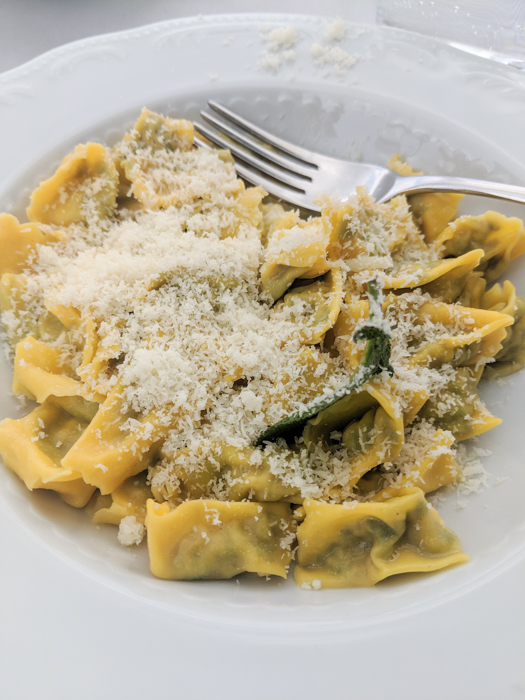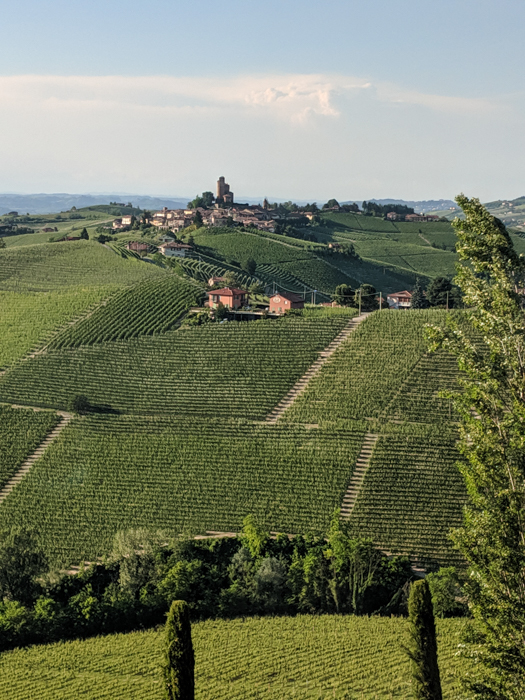
Exploring the lovely village of Serralunga d’Alba in the heart of the Langhe district in Piedmont, one can not resist stopping to enjoy a meal on the terrace at Trattoria Schiavenza, soaking up the splendid vineyard view. Locals and tourists both dine here, as well as our guests on our Barolo Walk and Wine tour, but I’m not sure how many of the tourists know that one of the best Barolos in Serralunga is being produced just beneath their feet.
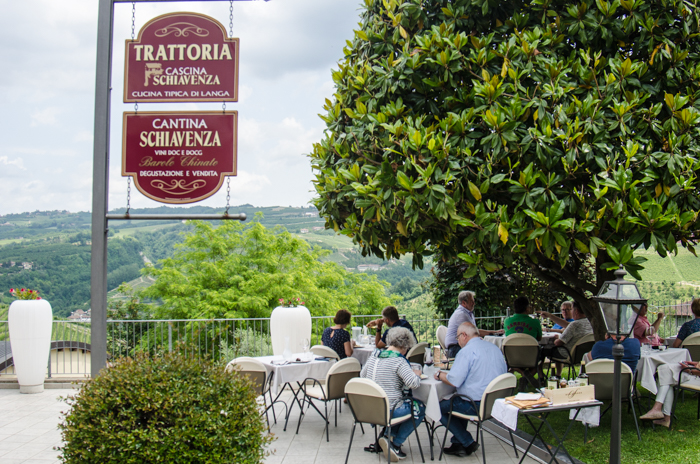
I recently met Walter Anselma, one of the current owners of Schiavenza, to learn more about his unique wines. Founded in 1956 by Vittorio and Ugo Alessandria, the estate was formerly owned by Opera Pia Barolo, a non-profit foundation founded by the Marchesa di Barolo to help the local poor, and the vineyards were typically worked by sharecroppers. Schiavenza is the local dialect for sharecropper. Today, the estate is run by the second-generation Alessandria sisters, Enrica and Maura, and their husbands Luciano Pira and Walter Anselma.
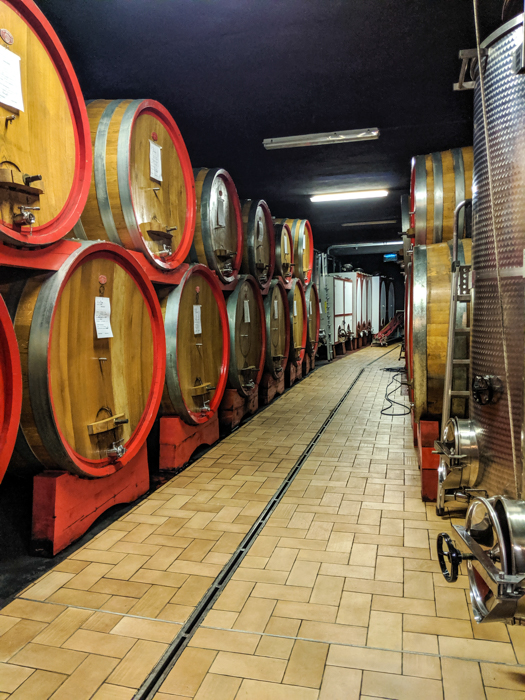
Walter meets me in the small tasting room, and apologizes that the cellar is not set up for tours. He offers to bring me through, if I am comfortable navigating the narrow metal circular staircase down. I am, and we head down to see their operation. A long, narrow tiled walkway leads us first past wood “botti”, large Slovenian oak barrels used for aging, then a few stainless tanks, then several cement cisterns. Walter describes their production process: all wines are fermented in the cement cisterns, using only naturally occuring yeasts – no yeast is added. Following fermentation, the wines are moved to larger botti for aging. There are no barriques, Walter comments that he want to “taste wine, not wood.”
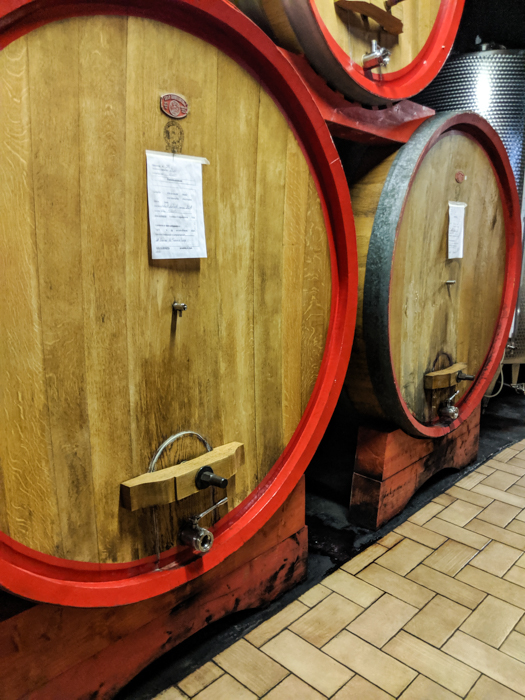
The next step is very unique to Schiavenza, and Walter – the frequency with which they “rack” the wines as the age. Racking, called “travaso” on Italian, is a method in wine production of transferring wine from one barrel to another, using gravity rather than a pump. A pump would disrupt the wine by mixing in any particles that may have settled in the barrel. This process is done several times during the aging process, more often at first, but eventually time between racking extends to months. Walter does is much more frequently, every 10 days for some wines like Barbera, less frequently for others. Barolos that age for 60 months are racked every 3 months.
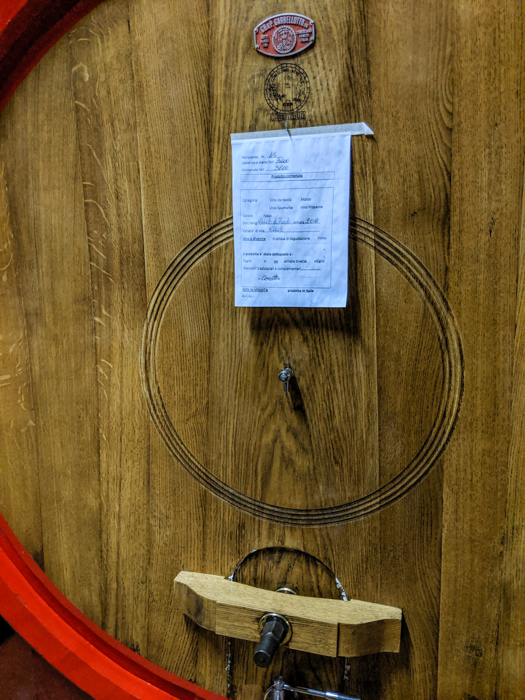
Each time a botti is emptied during racking, it must be cleaned of any sediment before being refilled with another wine. Cleaning is done by hand, and involves Walter himself squeezing his entire slim frame into the dark interior through the small entry hole at the bottom of the botti. He cleans the entire inside with only water and a brush, no harsh chemicals. If more than three months pass between racking a barrel, the sediment becomes too hard to wash off with water, and they would need to scrape off 2-3 mm of wood from the inside of the barrel to remove it. Walter emphasizes that clean barrels mean good air circulation, clean wines. I commented about the amount of work involved with this dedication to frequent racking, and Walter downplayed it, saying most of the work occurs in the winter months, when there is not a lot of other vineyard work to be done.
I ask Walter to share his thoughts on organic wines. He belongs to an Italian group of producers dedicated to sustainable practices, but he isn’t certified by an official ‘biologic” wine entity, it is too onerous, and he goes on to share several anecdotes about local farms that are supposedly organic but he sees them doing things that are suspect. He gives a very personal reason for his clean production methods – his family drinks his wines daily, so he very much wants them to be healthy. He uses no pesticides, no harsh chemicals. He does occasionally use a tractor, and employs staff from the local cooperative.
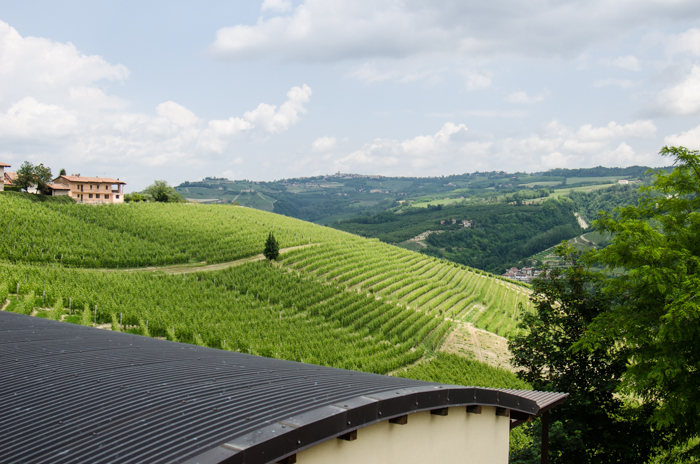
But there are two tasks that are only ever performed by Walter and his brother-in-law Luciano: pruning, and green harvesting. These require expertise, and are too important to outsource. Pruning, done in the winter and early spring, is essential for training grape canes and producing quality fruit yields. Later in the season, it is done to allow light and air to reach the plant’s interior. Green harvesting, done in late summer, is the harvesting of unripe green clusters of grapes from the vine. It is a form of crop thinning to help manage yield and to enable the remaining grape clusters to fully ripen according to the winemaker’s aims. This is especially important for a prolific grape like Nebbiolo.
Walter leads the way back to the small tasting room, where we try a taste of his amazing wines. Schiavenza produces 48,000 bottles of wine annually.
We begin with the 2018 Dolcetto d’Alba. I ask why they still produce a Dolcetto, as many wineries are turning all their vineyards over to the more profitable Nebbiolo. Walter insists that Dolcetto is still an important wine, the “everyday” drinking wine the locals enjoy. They produce 7,000 bottles a year.
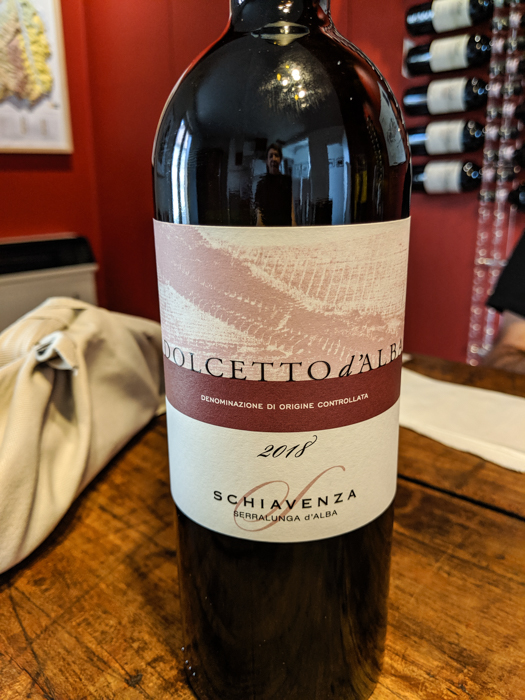
Schiavenza 2018 Dolcetto d’Alba
100% Dolcetto, from different vineyards all located in the village of Serralunga d’Alba. Don’t be misled by the name, Dolcetto is a dry wine. Ruby purple in color, with scents of red fruits and cherry. Strong fruit flavor, austere with a bitter almond finish.
Schiavenza 2017 Barbera d’Alba
100% Barbera, from their vineyard located in Perno in the village of Monforte d’Alba, just south west of Serralunga. Again the same question, why still plant Barbera when you can make more money selling Nebbiolo? The vineyards in Perno are very well-positioned, but brother-in-law Luciano believes these vineyards are absolutely optimum for Barbera. Intense ruby color with purple-violet reflections. Intense ripe cherry taste, lots of spice. Nice acidity.
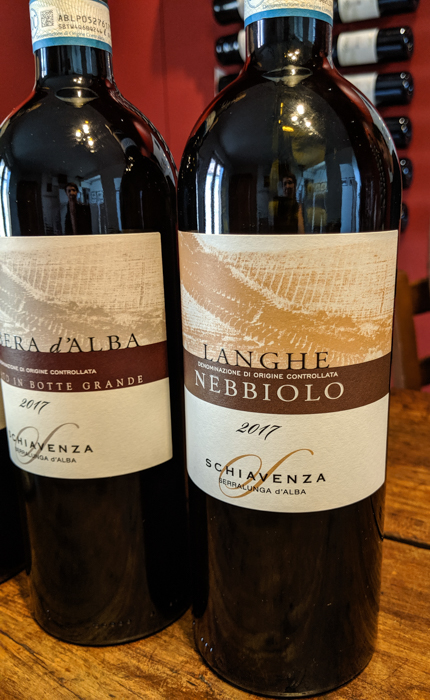
Schiavenza 2017 Langhe Nebbiolo
100% Nebbiolo, from the same vineyards in Monforte d’Alba. If they used these grapes in any of their Barolos, they would not be able to use the “Serralunga d’Alba” name on the bottle. Light ruby in color with hints of orange. Delicate scents of cherry and rose, flavors of cherry, licorice. Nice tannins and good acidity.
Schiavenza makes 4 Barolo wines. In bad years and good, they are all made in exactly the same way – same fermentation, same aging. The only difference is the terroir of the 3 vineyards.
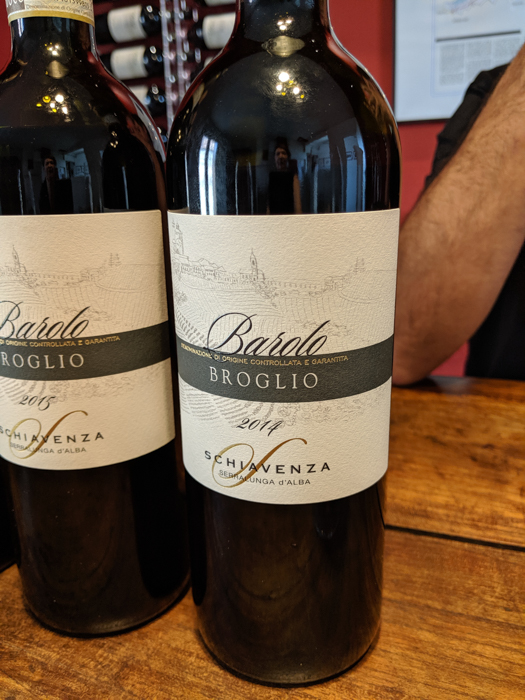
Schiavenza 2014 Broglio
100% Nebbiolo, from the Broglio hamlet of the village of Serralunga d’Alba. Walter describes the earth here contains lots of clay, so the Nebbiolo vines here are particularly prolific. They do extensive green harvesting, removing almost 40% of the grapes. Lighter ruby red color with orange reflections. Aromatic, with intense floral notes of rose and fruit jam. An elegant wine, full bodied, with great structure and tannins and persistent finish.
Schiavenza 2014 Cerretta
100% Nebbiolo, from vineyards located in the Bricco Cerretta Cru found in Serralunga d’Alba. Lighter ruby red color with orange reflections. Aromas of rose, red fruits, tobacco. Flavors of red cherry, raspberries, licorice, with an earthy minerality. Full bodied with nice acidity and pronounced tannins.
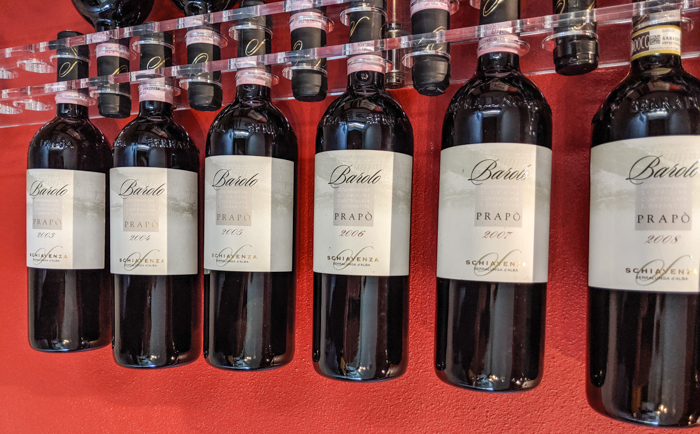
Schiavenza 2014 Prapò
100% Nebbiolo, from Schiavenza’s flagship Prapò vineyard in Serralunga. Great south-east exposure, this vineyard has terroir with lots of limestone, less fertile than Broglio. There is almost no green harvesting done here. Intense ruby red color aromas of berry fruits, violet and rose. The palate is well rounded and intense with elegant tannins.
Schiavenza Barolo del Comune di Serralunga d’Alba
100% Nebbiolo, a blend of grapes from the preceding 3 cru areas. Lighter ruby red color with orange reflections. Aromas of rose, cherry jam, tobacco. Flavors of cherry, raspberries, licorice, leather. Elegant structure, full bodied, nice tannins, long finish.
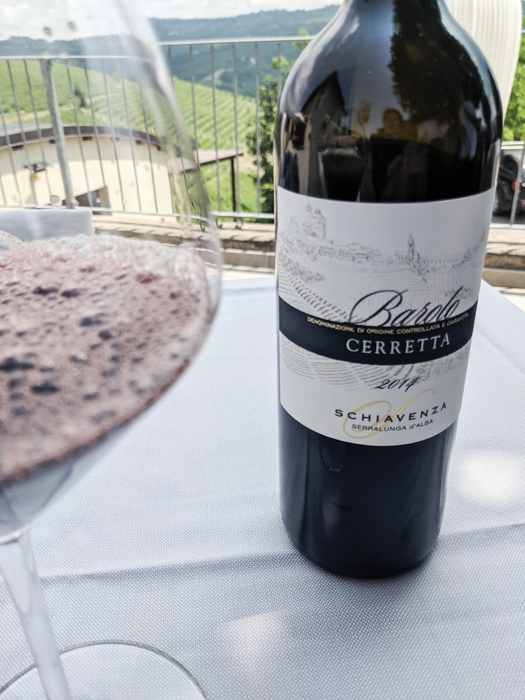
After my tour and tasting, I had a very nice lunch at Trattoria Schiavenza. The trattoria is overseen by the Alessandria sisters, Enrica and Maura, featuring the traditional dishes of the Langhe area. I enjoyed the carne cruda, ravioli del “plin“, and budino for dessert, accompanied by a glass of the Cerretta Barolo. Wonderful food to enjoy as I gazed over their Broglio vineyards below.
